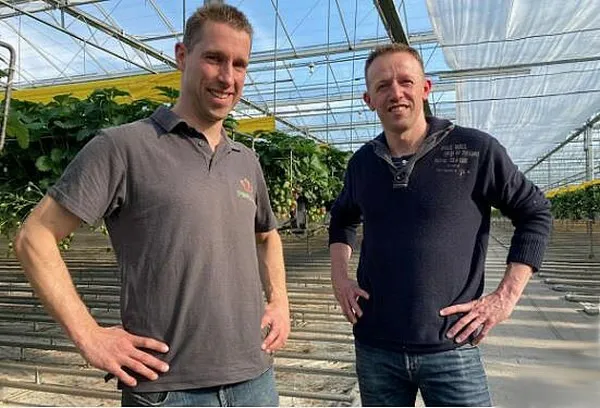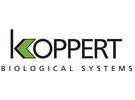Driven by the ambition to do things even better, strawberry grower Rob van Enckevort from De Peelkroon BV was keen to take Plant Empowerment a step further to improve the fundamental health of his crops through nutrition.
“Quality is always an issue with strawberries, just as with any fresh produce, and today’s retailers – and consumers – have very high expectations,” explains Rob. “We like to see ourselves as pioneers in the business and are always thinking ahead and looking for ways to do things even better in order to safeguard our future. So we wanted to reduce our use of chemicals in order to supply an optimally ‘clean’ and residue-free product to our customers, but without affecting the quality and shelf life of our strawberries.”
Differences between crops
Rob was already conducting various climate-related steps in line with the Growing by Plant Empowerment (GPE) principles, such as using screening, reduced venting, and misting. “But there are some fundamental differences between how strawberries grow and how cucumbers, peppers or tomatoes grow. This means that the basic principles have to be applied differently,” states Rob. “In strawberry plants, the growing point is beneath the leaves so they already have a natural canopy or ‘screen’.
In tomatoes, the growth occurs at the top of the plant, plus production continues steadily throughout the cycle. In contrast, all the strawberry flowers blossom at the same time, and once they’re gone they don’t come back until next season. As a grower, you sometimes need to use temperature and light to keep the speed going and make room for new fruits, but if they grow too fast the fruits will be too small. You’re continuously trying to balance that conflict, which results in a kind of wave-like rhythm,” he continues.

Biostimulants
Rob had previously worked with Mark van der Werf from Koppert Biological Systems – a GPE Implementation Partner – in 2017. “The aim was to improve the resilience of strawberry plants by adding biostimulants to create a healthier root zone. This makes the plant less susceptible to pests and diseases such as mildew, which can be a big problem for us,” recalls Rob. “The results were not what we hoped for but it didn’t stop us from continuing the search for healthier plants.” In 2019, De Peelkroon BV joined forces with seven other innovative strawberry growers in the Venlo region to set up a collaborative R&D partnership called Fragaria Innova. One of its focus areas was plant health.
Lessons learned
“We enlisted Mark’s help to leverage the lessons learned from the trials in 2017 and to fine-tune the approach for us. One of the Fragaria Innova growers dedicated 2,500 m2 for trials to test the new approach. This gave me the confidence to switch to this system on 4.3 ha in August 2020, and I will be rolling it out throughout the whole company next season,” he adds. They worked together to identify the critical moments for strawberry plants to see when an extra boost could be needed. “For example, one critical moment is when the plant is full of flowers, since that ultimately determines how much yield you will get at the end. It’s also important to ensure good pollination and good setting, otherwise, you will be left with smaller fruits. So that’s when we add biostimulants to give an extra push,” says Mark.
Plant health
“Good nutrition is the foundation for plant health. Two groups of minerals are crucial to reach a higher level of plant health: nitrogen and trace elements,” continues Mark. “Nitrate – the common form of nitrogen – is generally oversupplied in most crops. This oversupply shuts down soil life and makes the plant more susceptible to pests and diseases. Secondly, it’s necessary to boost the availability of trace elements because they are essential in almost all biochemical processes in the plant, including resilience. At De Peelkroon BV, we are now supplying nitrogen in an organic form and at the same time introducing trace elements in a plant-available form. This seems to be a good combination along with reducing the fertilizer input,” he explains.
To monitor the effects of the nutrition strategy, plant leaves are sent away to a lab for plant sap analysis once a week. Rob then works with Mark to discuss the results and decide what action to take next. It is a steep learning curve, according to Mark: “The total approach is almost like playing a game of chess on several different boards at the same time. Every time you identify the limiting factor and change it, something else becomes the limiting factor. We’ve partly tackled the nitrogen issue and are working on the trace elements. And oxygen is very important for roots and microbes, of course, so we’re trialing nanobubbles at one location. It seems to have a positive influence, so perhaps that could be the next missing link.
Better quality and shelf life
“The crop did quite well in the autumn despite a long period of hot weather, and the quality of the fruits was so much better than with the traditional method that we’re now using this approach for our entire 5 hectares,” states Rob. “In terms of plant issues, mildew is much less severe than in it was in the past and the plants also seem less attractive to whitefly.” Moreover, both the quality and shelf life of the strawberries have improved, he says: “We’re now achieving almost 99% first-class fruits, which has reduced our labor costs in terms of grading. The fruits generally feel firmer and more robust with strong skin, and they stay good for about a week after purchase. All in all, this approach makes us a more reliable supplier.”
More predictable outcomes
All the historical data that is being built up provides a valuable foundation for exploring precisely what a strawberry plant actually needs in terms of nutrition. “Ideally, we would like to utilize all the data so that the outcomes become predictable. In that case, plant sap analysis would become a monitoring tool rather than a steering tool,” says Mark. “We’re very pleased with the results so far, of course, but there are still huge opportunities for further improvements. Following on from better quality and shelf life, we expect that systematically making life easier for the plants through nutrition will ultimately enable us to increase our yield too,” concludes Rob.
For more information:
Koppert Biological Systems
info@koppert.nl
www.koppert.com
